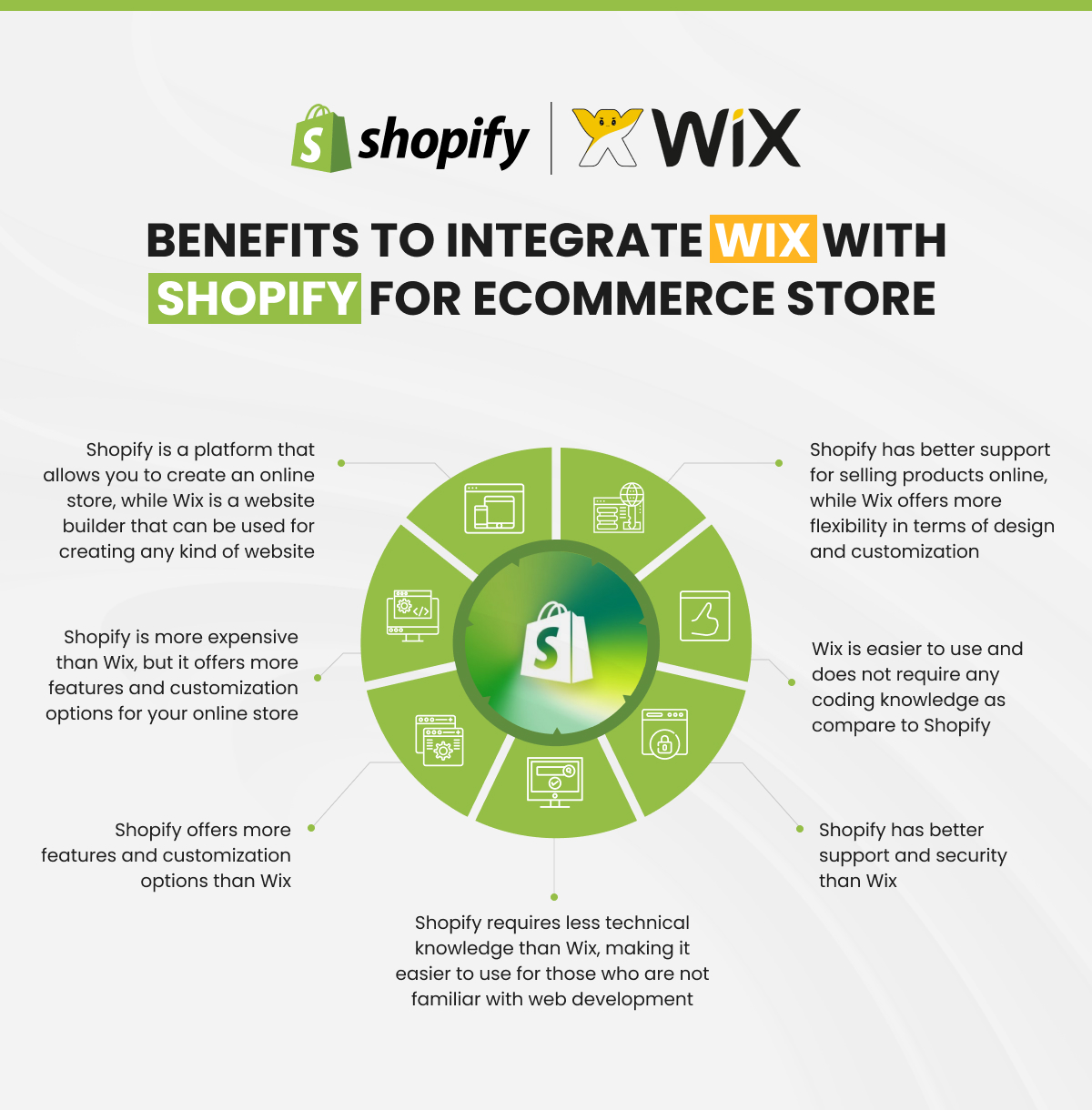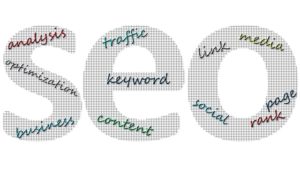Wix eCommerce vs Shopify: Which one is best Ecommerce platform for online store?
Last Updated | January 18, 2024
Table of Contents
What is Wix eCommerce vs Shopify?
Wix and Shopify are two of the leading and most widely used eCommerce website platform that comes with unique features and functionalities. The platforms are broadly meant to simplify the process of eCommerce web development for users who aren’t into coding or programming.
Now, since both of these are top-of-the-line eCommerce web development platforms, every time it’s about Shopify vs Wix, it’s a heck of a contest for some amazing features and unique functionalities offered by each of these platforms.
While at one end we have Wix; which is arguably one of the easiest and most user-friendly website development platforms equipped with high-utility eCommerce tools and a market reaching up to 110 million global users.
On the other end, we have Shopify, which is definitely right at the top when it comes to the eCommerce website platform. The platform is known for its robust features, incredible tools, and capabilities to power eCommerce stores. Currently, the platform is powering 600,000 eCommerce stores development globally with yearly revenue reaching over $50 billion.
Now, in this blog, we will be having a detailed comparison of Wix eCommerce vs Shopify. And since it’s hard to rank each platform adequately without actually comparing the strengths and weaknesses of each of them with respect to different features and capabilities, so, we will be comparing different features of the two platforms to give you the best idea about which platform would suit your needs and be the right choice for your website/eCommerce store.
Read Also Teespring VS Shopify
Why and How to Compare Wix eCommerce vs Shopify?
As we said above, the two platforms are quite similar with respect to their purposes and features including;
- Both platforms are meant to help users with no coding skills launch their website/eCommerce stores
- Help untechnical users to create, manage and update websites/eCommerce stores
- Help you sell custom products
However, when we dig a little deeper into the purposes and capabilities of each of these platforms we got to know that each one of these is meant for different purposes.
For instance, Wix is primarily a website builder platform that aims to enable untechnical users with limited or no coding skills to set up their first website using its’ super-easy drag-and-drop website designing features. The platform was initially conceived as assistance to create content-based websites; which means that initially it only supported the development of certain types of websites including;
- Blogs
- News sites
- Brochure sites
- Portfolios
And other types where the key priority and purpose of the website was to display the content.
Contrarily, when we talk about Shopify, it was specifically targeted at users with limited or no coding/programming skills looking to sell online.
Again, while the platform on the outside has a similar purpose of helping untechnical users develop websites on their own, each one of them targeted different markets initially. And while today Wix has diversified its offerings and can now also be used for developing eCommerce websites, you will notice that it’s more suited to develop content-driven sites, whereas, Shopify remains the choice of users when it comes to eCommerce website development.
However, it’s not as simple as that when it comes to making decisions about Shopify Vs Wix, as you have to drill down to the very technicalities and nitty-gritty details of each platform to choose the best platform for your needs.
So, let’s just cut to the chase and start our Shopify vs. Wix comparison and see what each of these platforms got to offer.
Wix eCommerce vs Shopify – Design
Ok, it is just irrelevant to say that design matters. I mean when you are looking to compete literally hundreds and thousands of similar stores offering more or less similar products, you need a solid design that can help you get noticed and stand out amongst the crowd; right?
Thereby, we are going to start our Shopify vs Wix comparison by looking at the design features offered by each of these platforms.
Now, to begin with, both of these platforms offer some really tempting and professionally designed website design templates (both free and paid). However, when it’s about open up an eCommerce store, Shopify’s templates are designed specifically to help you sell more; thanks to its focused vision on eCommerce website development.
Now moving on, another important aspect to remember when it comes to Wix vs Shopify website design is the responsiveness or mobile-friendliness of the design. Because, according to the stats, nearly 50% of online shopping in the USA is completed using a mobile device, which clearly indicates the significance of keeping an aesthetically pleasing and functional mobile design. Now, when we compare Wix vs Shopify templates for mobile responsiveness, both come right at the top with templates designed professionally to work perfectly on all mobile devices.
On the credit of Shopify, the independent designers working with the platform ensure that you got some pretty amazing and updated themes purposefully developed for a range of industries. You can always get yourself a nicely designed and fully functional paid template from the Shopify store, which even though might be a little on the higher side (starting from $180), however, since it’s a one-time investment it’s definitely worth it.
On the other side, Wix offers hundreds of free templates that can easily be used to create websites for a range of industries. However, one space where Wix does lack is that the themes aren’t specifically designed for eCommerce stores (even though there are some 50+ dedicated eCommerce templates). Nonetheless, all template designs offered at Wix are nicely designed and super-easy to edit (we will discuss customization options in our next sections).
One big downside of Wix is the fact that it doesn’t allow you to switch designs once you have chosen one. Which makes it almost impossible to rebrand your store/website when you feel like doing so down the line.
Not to forget, both platforms offer industry-specific features with templates; which makes life that much easier for users looking to just start their online stores as quickly as possible.
Wix Stores vs Shopify – Custom edits
Customization is definitely a noteworthy thing to discuss when it comes to website design, right? Well, thankfully both of these platforms allow customization options for users and you can easily customize the selected themes using HTML and CSS.
With Wix, you can make custom edits to your website design template through “Wix Code”, which can be accessed by clicking “Code” and then “Developer Tools”. Here, you can have complete customization control of the template and design your way through everything you want.
With Shopify, it’s even easier to make custom edits for the design templates. You can either click “Edit HTML/CSS” to access the coding page or work your way through the code or if coding isn’t your thing, you can alternatively use the simple drag-and-drop editor to make any aesthetic changes you want in the design.
So, to end conclude, we can safely say that both of the platforms offer pretty robust and comprehensive design features for users. However, Shopify is better suited for users looking to design an eCommerce store, whereas, if you are looking for just a static site or not looking to sell anything, Wix with its free templates and customization options might be a better option for you.
Wix Store vs Shopify Themes Development
Now moving on with our Wix eCommerce vs Shopify comparison let’s see what each of these platforms has to offer when it comes to themes.
As said earlier, Shopify certainly scores higher when it comes to eCommerce website design and development; since it’s dedicated to that purpose. The platform offers 60+ professionally designed themes for eCommerce stores that come with exquisite aesthetics, superior functionalities, and high responsiveness to work equally great on desktops and mobile devices. And if you just don’t like something in the theme, customizing is fun with its live editor that enables drag-and-drop customization of themes. Or if you know little something about coding, you can always choose a CSS/HTML editor to manage and tweak themes just the way you want. The only catch here is that you will be paying a one-time fee ($140 – $180) to get access
Moving on to Wix, the platform offers a greater number of free themes (60+) for eCommerce stores. Just like Shopify themes, the themes offered at Wix are professionally designed, and aesthetically pleasing to ensure a superior user experience. What’s not great about Wix is that the themes offered on the platform aren’t responsive and you would have to manually edit all the elements in the themes to get them displayed right in different mobile devices. Moreover, while the platform does offer plenty of customization features, these aren’t as comprehensive as those offered by Shopify.
So, I guess we have a clear winner for Shopify vs. Wix for eCommerce; and that’s Shopify. Thanks to its completely responsive and specifically eCommerce-focused themes, you are certainly up for a better user experience and an integrated eCommerce store experience with Shopify.
Wix or Shopify for e-commerce – Development Time
The next in line for our Wix eCommerce vs Shopify comparison is the development time, which again is an important consideration for users looking to start their stores.
Now, starting with Wix, the platform offers three different options as compared to Shopify website development including;
- Wix Editor
- Corvid
- Wix ADI
The “Wix Editor” is the simplest of all options, where you can simply choose a pre-existing template to create your store’s structure while populating it with the content later. Since it’s simple and doesn’t require much technical knowledge, it’s also the best for beginners and users with no prior development skills.
Moving on, the “Wix ADI” option is more of an advanced development option, where ADI stands for Artificial Design Intelligence. The option enables users to create completely customized websites integrated with all the elements (videos, content, and images) automatically. This is achieved by the Artificial Intelligent algorithms, which ask users a few basic questions about their aspirations and thinking of the website and then come up with a completely automated sketch of the website. Now, as you can expect, this won’t be the most unique of the most professionally designed store because the algorithm will have to pull the best available content about your business from the web, and obviously it would be hit and miss approach, and would primarily depend on your online presence.
Lastly, the “Wix Corvid” approach lets you access the Platform’s API and customize your way through the website development. Obviously, this option is suited for users with prior coding and development skills. The plus side of this development model is that it enables you to have more control over the development phase and customize it to your liking.
And regardless of the option you choose, all three options give you pretty fast development times (especially the automated one). However, what you choose will eventually depend on your requirements and skills.
Now, moving on to the Shopify development plan and process, the platform offers a single development interface; the options available to you may vary depending on the account type (paid or free), nonetheless, the performance and consistency of the interface remain the same.
Perhaps, the downside (not literally for everyone) of working with the development interface of Shopify is that you would be working on the backend, which means that you would have to change, edit, add or delete any element from the design from the backend and then save and publish it to be able to view the changes. This is similar to using a common WYSIWYG editor which is used in WordPress development as well. You can simply add or remove the content from the backend and then publish it to be able to view it. This approach sort of removes the added layer of flexibility as you find with the Wix editor, where you are able to view the changes in design as you make them.
But, if you haven’t used Wix’s development editor, you wouldn’t know the pain and hard work that goes into managing that fiddly editor where you have to literally struggle your way through to manage the layout coherently. That’s because as you move even one element, the other elements will change their position automatically and then you would have to adjust with other elements and so on.
On the other hand, the WYSIWYG editor offered at Shopify works smoothly and adjusts seamlessly as you make changes to the design, so you don’t really have to worry about adjusting elements over and over again.
Not to forget, when you are working with Wix, you basically have to develop two separate sites for mobile and desktop versions, because the templates and design aren’t responsive. So, you will be working on two completely different versions of the website, which is definitely not just painstaking but frustrating.
So, who’s the winner? Well, again it primarily depends on your requirements. However, if we are to look at the ease and pace of development, Shopify is the clear winner with a more robust, well-integrated, and responsive development process, while Wix may be too cumbersome for the liking of many newbies.
Benefits to Integrate Wix with Shopify For eCommerce Store
Which is Better Wix or Shopify – Payment Gateways and Fees
Ok, the next functionality we will be looking at is the Payment gateway and fees, which again is an important functionality for any eCommerce store.
Again, since Shopify is basically a purpose-built platform for eCommerce stores, it comes with all major payment gateways which may count up to over 100. However, you would be liable to transaction fees to use any payment gateway other than Shopify Payments. To further enhance the online shopping experience for customers and stores, Shopify also offers stores to add tipping during the checkout process or customize the text asking for donations of charity and others.
Moving on, Wix also supports some traditional payment gateways including PayPal, Square, Affirm, stripe, and others, however, it currently doesn’t support digital wallets like Amazon Pay or Samsung Pay. However, on the plus side, Wix doesn’t charge any transaction fee for any payment gateway.
To sum it up, while you may save the transaction fee on Wix, Shopify is definitely the better and more comprehensive option when it comes to payment gateway integration for your online store.
Budget and Pricing
Perhaps the biggest difference between the two platforms is the fact that Wix offers a completely free plan, whereas, Shopify only offers a two-week free trial.
However, Wix’s free plan does come with a catch which is the limited functionality (quite expected). Also, with a free plan you won’t be able to sell anything or link it with a domain; and last but not least, be ready to bear a large amount of advertisement. So, while practically the Wix free plan isn’t a viable option for business purposes, it nonetheless could be great to try out the platform.
So, once you move towards the paid plans for Wix, you get the whole bunch of categories (8 to be exact) available here. These categories can broadly be segregated into two categories namely; Website and Business and E-commerce.
The “Website” is the basic plan which may cost from $13 to $39 monthly, depending upon your features and functionalities. The plan enables you to create “general” websites.
The “Business and E-commerce” plan on the other side may cost from $23 to $500 monthly and offer robust functionalities you need to sell products from your store.
Shopify pricing
Moving on to the “Shopify Pricing”, the structure here is much simpler and comprehensive. There are 5 plans available here including;
- Shopify Lite – costs $9 monthly
- Basic Shopify – costs $29 monthly
- Shopify – costs $79 monthly
- Advanced Shopify – Costs $299 monthly
- Shopify Plus – cost is negotiable but in the range of $2000 monthly
Read Also Shopify Plus vs Shopify Advanced
As we said above, Shopify doesn’t offer any permanent free plan (only a two-week free trial period), however, it does offer some comprehensive plans. The most basic plan “Shopify Lite” comes only at $9 per month, however, this won’t help you to create a functional website; rather can be used to integrate it with:
- Facebook page to sell products
- A physical store to sell others people products and manage inventory
- Shopify’s Buy Button, which can be used to sell goods on social media, blogs or an existing website
The highest plan “Shopify Plus” is essentially an enterprise-grade solution that brings to the table a host of advanced features and functionalities including security, APIs, and fulfillment to ensure a superior user experience for the store, with a range of automation tools meant to enhance the workflow process and systems for the online store.
To sum up the Wix vs Shopify for pricing, the choice again boils down to the purpose of the website. If you are looking for a general-purpose content-based website and not the products; Wix certainly offers better value with its free plan, as well as, its basic $13 monthly plan that comes with decent features.
However, if you are into eCommerce website development, Shopify certainly offers better features and functionalities; specifically meant to make your online store a success story. And even though the basic Shopify plan which supports eCommerce activities costs a little more than the Wix plan, the features, and support offered by Shopify certainly make it a better choice.
Marketing Tools
Moving on to the marketing tools; which are essential for the success of any eCommerce store, let’s compare the Wix eCommerce vs Shopify marketing features.
Starting with Shopify, the eCommerce platform relies heavily on third-party app development for marketing purposes. And while easy integration with third-party apps does offer greater flexibility, it may be difficult to compare the two platforms when you have so many created Shopify design apps integration options.
When we talk about Wix, the platform has certainly altered the eCommerce marketing space by introducing its Wix Ascend. The new marketing tool “Wix Ascend” is essentially an end-to-end marketing solution that enables users to manage their store’s marketing campaigns easily through a unified platform.
Now, let’s look at some different marketing aspects of the two platforms and see how they compare to each other;
Social Media Integration
As mentioned above, Shopify essentially lets you integrate various third-party apps into its ecosystem; this also includes connecting the stores to popular social media channels including; Facebook & Instagram, as well as, some big marketplaces like Amazon and eBay.
On the other hand, Wix also supports easy integration with Instagram, so you are able to reach your target audience and sell seamlessly through popular social media channels.
Email Campaigns
As discussed above, Wix offered its users an integrated and comprehensive marketing tool “Wix Ascend”, which can be sued to manage all marketing campaigns from one place. The tool can be used to run three email campaigns without any special subscription. However, you can increase your quota by subscribing to the “Ascend” tool with a monthly payment.
Shopify on the other hand enables users to create interactive email campaigns from its admin page, whereas, if you want more flexibility and customization, you can always integrate third-party email marketing apps like Privy and others to further enhance your email campaign and increase sales.
Blogging
With Wix, you can create aesthetically pleasing and enchanting blogs with ease. However, the only downside here is the archive feature (which lets you save old posts for readers to access and read). If you really want this useful blogging feature, you would have to use professional blogging-specific tools like WordPress.
Moving on to Shopify, the platform actually disappoints in this aspect. The platform comes without any built-in support for analytics, social bookmarking, or blogging. Whatever blogging feature is available with the platform, these are quite bleak and not of much help in the business world.
Shopify or Wix for e-commerce – SEO
Search Engine Optimization (SEO) is an important aspect to consider for the success of any eCommerce store. You need strong SEO tools and features to be able to get a higher ranking on the search engine, increase visibility, and improve your chances of making sales.
Some SEO features offered by Wix and Shopify both include;
- Add/edit meta titles and descriptions
- Custom URL slugs
- Alt text for images
Apart from these basic SEO tools, Wix also offers additional tools and features like Keyword research, and suggestions for phrases and words with high-volume searches. Thereby, Wix certainly has an advantage over Shopify SEO when it comes to SEO tools and functionalities.
Customer Help and Technical Support
Next in our Wix Vs Shopify customer support comparison, we have the customer help and technical support offered by each platform. In general, both platforms offer some level of customer help and technical support including;
- Phone support
- Email support
- Help accounts on social media
- Forums
- Help Center
Shopify also offers 24/7 phone support, which is not currently offered by Wix, which puts Shopify in an advantageous position in our comparison.
However, Wix makes it up nicely for its lack of 24/7 phone support with its in-editor help, which can be sued directly within the editor to receive help. All you need to do is to hover the mouse over the editor’s question marks and you will get answers for some common queries.
Overall, the support offered by Wix is better and more robust than Shopify, even though it currently doesn’t offer 24/7 support. Still, when we talk about help and support, it’s not just about the time but the quality of the support, one aspect where Wix certainly has an advantage.
Sales features
When it comes to sales features, Shopify certainly flexes its muscles with some great sales features; making it one of the top choices for eCommerce platforms.
An honest Shopify vs Wix eCommerce comparison for sales features would simply reveal that while Shopify is like a Swiss Army Knife (complete solution) for an eCommerce store, Wix, certainly lags big time in this aspect.
Product Types
You can sell products and services on both platforms, however, you would need an app to sell products through the Wix store, whereas, for Shopify, you would require third-party app integration to be able to sell your products online.
Product Presentation
You need your products to appear good to be able to drive sales, it is as simple as that.
For this reason, Shopify which is a specific eCommerce platform brings a host of theme customization features that gives you the freedom to add any many items and variants of each item as you want. You can also integrate third-party apps to include product zoom functionality for better product presentation and more sales.
Wix doesn’t lag much behind when it comes to product presentation and offers various features and tools that help make your products shine. The platform also offers a built-in video function that can be leveraged to improve the customers’ shopping experience, whereas, you can also add a zoom feature easily into the store.
Shipping Options
Shipping is another aspect where Shopify is right up with the very best of the industry. The platform lets you control and manage each and every step of the shipping process using apps from syncing with the shipping providers to offering free shipping, as well as, offering alternative shipping providers. The platform also enables stores to offer contact-free shipping options, adding more flexibility and attractiveness for customers.
Wix also offers some great shipping features like setting tax rules, as well as, letting you leverage the dropshipping. Moreover, the platform also brings easy integration with ShipStation, a unique shipping solution to simplify and process of shipping for eCommerce stores.
Again to sum up, while we can safely say that Shopify does bring a lot more value and muscle to the Sales Features; the end choice will depend on the context. If you aren’t looking to sell tons of products and scale your business beyond boundaries, Wix offers enough features for stores to enjoy sustainable growth with simplicity, however, for stores looking to brand themselves and scale big, Shopify certainly brings a lot more muscle to the game.
Inventory Management
Shopify brings to the table comprehensive inventory management features, where you get access to robust tools to manage and navigate your way through the inventory.
Wix on the other side is more suited for smaller stores with limited inventory. However, you can certainly add and manage multiple products with its high-utility and simple inventory management features.
And again, the choice of the platform will depend on the context of the store. For people looking to build big brands Shopify certainly got the right muscles, whereas, if you want to remain a small to mid-size businesses and long for simplicity, Wix does offer some interesting features.
Mobile Responsiveness
Perhaps the biggest downside for Wix is its unresponsive website, which forces users to create two different versions of the website. Also, as said above, it’s a pretty hard and frustrating experience to set the layout for desktop and mobile versions on Wix.
Shopify on the other hand offers 100% responsive templates and designs, which are auto-adjusted, so you don’t need to go over the layout again and again to finalize the design layout.
Obviously, Shopify is the clear winner and Wix loses big time in our comparison of Shopify vs Wix for responsive websites.
Application Integrations
Wix and Shopify, both platforms offer users dedicated app stores to add features to their stores.
However, the difference here is that while the app-store on Wix includes apps that can be integrated with your site for additional features, the app store for Shopify is meant for third-party app integrations and add-ons.
Final Thoughts
So, there you have it, everything you want to know about Wix Vs Shopify platforms for eCommerce website design, development, and success. if you have already gone through the blog completely, you would have guessed that there is no clear winner here, rather the choice of the right platform will depend on the context and requirements of the store. Here’s a summary to help you get the crux of the blog:
Choose Shopify if:
- You are looking to go big and have scaling plans for the future
- If you are a dropshipping business in Canada, the UK, the USA, and UAE
- If you have a large inventory
- If you want more security and options
- If you want more Shopify payment gateways
Contrarily, you can choose Wix if:
- You are looking to run a small and easy to manage the store
- You don’t have a large inventory to manage
- Content creation is your main approach to attracting traffic
- You are looking for greater design flexibility
Shopify vs Squarespace vs Wix: Which one is best and why?
Wix, Shopify, and Squarespace are three of the leading e-commerce website design and development platforms, with each platform coming with its strengths and limitations. Overall, Wix is the easiest platform to manage, whereas, Squarespace also offers pretty neat features that are simple to manage. Shopify is overall the most robust platform for an intuitive interface and strong functionalities.
Wix vs Shopify vs Squarespace: How to compare with each other?
Shopify, Squarespace, and Wix all come with their unique set of features. While all three platforms offer some great features, Shopify is definitely the most comprehensive of all with advanced features and thereby the clear winner. Squarespace on the other hand does come with impressive inventory management tools, whereas, Wix comes as the easiest of the three platforms with great design functionalities.
Is it cheaper to sell on Shopify vs Wix vs Weebly?
Shopify is the most expensive of the three platforms, however, the platform comes with a comprehensive range of features and functionalities including sales & marketing features required to run an eCommerce store successfully. And while you have cheaper plans on Weebly and Wix, they come with limited functionality and features, thereby affecting the sales as the bottom line for online stores.
Why selling on Wix is a bad idea?
Selling on Wix is a bad idea because while the platform makes it easier than ever to create an aesthetically pleasing website, however, what seems to be a great website doesn’t necessarily would be great from the perspective of buyers. While you can create great web designs using Wix, it lacks the features, and functionalities required to attract and engage users to stores. It’s important to remember that websites are different from brochures and that they should be treated that way.




















